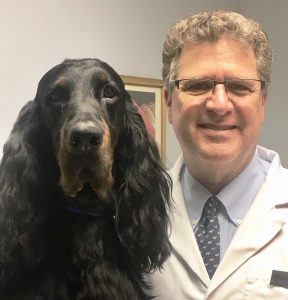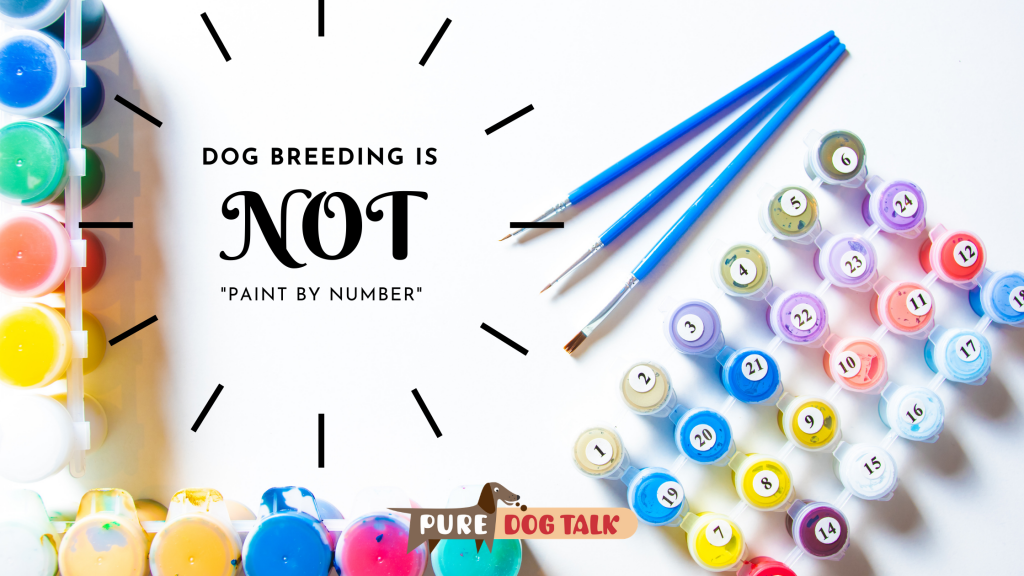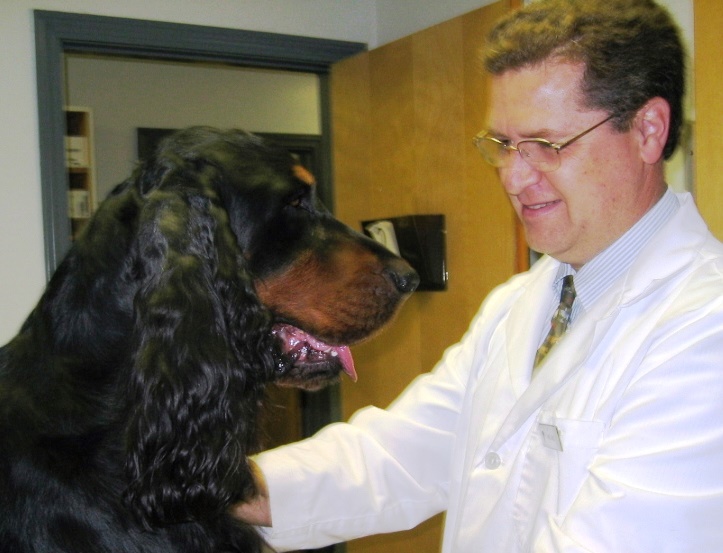453 – Dr. Jerold Bell: Dog Breeding is Not “Paint by Numbers”
Dr. Jerold Bell: Dog Breeding is Not “Paint by Numbers”
Dr. Jerold Bell returns in part two of a wide-ranging conversation with host Laura Reeves sharing more thoughts on popular sire syndrome, as well as addressing COI, inbreeding, linebreeding, outcrossing, CHIC programs, genetics of temperament and much more.
On owning a popular sire
“It does become a personal issue as well. It is a very ego boosting thing to have a popular sire. To have a top winning stud dog. To have a national champion … everybody wants to come and breed to it. To turn people down and say I’m not going to breed to your bitch, that’s also something that involves personal emotions. We need to really think about those things. So it is up to the stud dog owners to think about how their dogs are being utilized, what you have been able to evaluate from what they have produced so far and at what point you slow it down… It really is something that the stud dog owners also have to make some concerted efforts about not causing a popular sire syndrome.
On Coefficient of Inbreeding (COI)
Concentrating on a popular sire or a popular sire line, then everyone is going to be related to that sire or sire line and therefore their matings are going to have higher homozygosity overtime. So if I see an increasing homozygosity over the generations, that tells me that they are truncating on a sire line. So it is a very valuable tool to use in a population sense.
What’s happening now is that we’re being told to utilize the tool of the inbreeding coefficient as the goal of mating. So we’re artificially manipulating the inbreeding coefficients, so we can no longer look at it and say this is an honest assessment of how the breed is utilizing their gene pool. All we can say is it’s an honest assessment of how people are manipulating their inbreeding coefficients.
Linebreeding vs Outcrossing
This is why it’s wrong to breed based on increasing coefficient. You need to breed based on what issues do you have, what issues do you not have and what do you want. So if some people feel that some breeds are having diminishing litter sizes (for example) we need to select specifically against that issue of small litter size and breed individuals have larger litters. But it’s not necessarily an inbreeding coefficient thing. It is about deleterious genes that are accumulating in the background.
Some people can line breed and have wonderful things and some people if they even attempt a mild linebreeding we’re seeing lots of disease. If they have a high amount of liability genes in their breeding dogs, then they need to decide ‘who is most important to me that I want to pass things on. Who is less important, maybe shouldn’t be breeding it because they’re producing a lot of disease.’ Then outbreed to individuals that aren’t having those issues and bring in new genes. That’s the way you utilize outbreeding to bring new things in because you’re seeing an issue. But it’s not just a breed by number situation. It’s very specific for what you’re looking for or what you’re selecting against.
How to Utilize on Outcross
Outbreeding in order to bring things in that your line doesn’t have is the proper way of doing outbreeding. You need something that you’re not getting. You’re not getting that level top line consistently. You’re not getting that reach. You’re not getting that quality of hair or whatever other things you’re selecting, or hunting ability or herding ability or whatever else. Then you want to go to lines that have that, that you don’t have. You need to make a list of what you want, what you have, what you don’t have, what you don’t want in terms of diseases or deleterious traits or conformational faults.
Then you need to prioritize those things and actually in prioritizing those things you also need to understand that certain traits, certain diseases, if you have a genetic test, now certain things you can change in one generation. But other things, conformationally wise as well as health wise and hips and so forth, can take multiple generations of selection to get what you want.
They’re complexly inherited, there are multiple genes involved. So for those types of things you really need to prioritize over many generations of ‘this is what I want.’ You don’t get it in one generation. Or if you do get it in one generation, you can easily lose it in the next generation. Because you haven’t fixed all those genes in your breeding stock.
Conclusion
The bottom line is that there is no simple easy way out of breeding dogs. ‘What’s the one thing I can do that just makes everything good?’ … there isn’t one. This is a job and we need to pay attention to what we’re doing. We need to pay attention to what we’re producing.
You know one thing I say to breeders is that on the birthday of every single litter you’ve ever produced, take the last contact that you have and contact that owner and say happy birthday and how is your dog doing. Because if you don’t know what you’ve produced over time how can you help yourself. Breeding is complicated and there isn’t a quick fix. Breeding is an avocation. But if we’re going to do it, we need to do it well.
449 – Dr. Jerold Bell: Popular Sire Syndrome Defined
Dr. Jerold Bell: Popular Sire Syndrome Defined
 Dr. Jerold Bell, adjunct professor of veterinary genetics, Cummings School of Veterinary Medicine at Tufts University joins host Laura Reeves for a “hot topic” discussion of Popular Sire Syndrome.
Dr. Jerold Bell, adjunct professor of veterinary genetics, Cummings School of Veterinary Medicine at Tufts University joins host Laura Reeves for a “hot topic” discussion of Popular Sire Syndrome.
“How I define the popular sire syndrome would be the overuse of a single dog beyond their usefulness to contribute to the gene pool,” Bell said. “So it is an over use that is the issue. What happens with a popular sire is that their use occurs during a relatively short period of time, usually a one to two year period of time when they’re in a very active breeding stage. So what it does for us is that it does not provide the feedback in terms of their offspring and how their offspring develop before the overuse is already taken place.
“When I compare a popular sire to an influential ancestor in the background of a breed who has a very high contribution to every member of the breed From the past and people compare the two and say well why is it OK for an influential ancestor to be so influential but not a popular sire. It is the ability to evaluate over time.
“So that with an influential ancestor they remain influential because their descendants for each generation are evaluated against other individuals and they are decided to be used for breeding. That’s how that ancestor continues their influence through multiple generations of descendants whereas a popular sire, the only way to evaluate him is based on his phenotype, what he looks like, and not based on his genotype or what he will produce overtime. So that evaluation is not available and possible with the popular sire syndrome.
“We’ve seen a lot of popular sire syndrome in many breeds, where a popular sire gets replaced by his son, who becomes a popular sire, who gets replaced by his son who becomes a popular sire. And the entire breed truncates on that single sire line. The insidious issue with popular sire syndrome is that there are only so many quality bitches that are going to be bred with each generation. If a large portion of those quality females are all bred to a single male or a single male line, it’s sidelines the other quality males across the breadth of the gene pool that should be contributing to their gene pools in the next generation. The issue with popular sire, there are several issues, but one of the major issues is the loss of genetic diversity in the gene pool.
“We talked about the genetic diversity issue. The second issue is recessive deleterious genes that the popular sire may carry. Everybody has some deleterious genes in their background. With the popular sire, you don’t know what those deleterious genes are going to cause until a few more generations down the line when his offspring are adults and maybe they’re reproducing as well. Where a popular sire is obviously producing an issue and we need to go through a purging process to try to get rid of those deleterious genes and disorders, then you’re not just purging that popular sire but you’re also purging the quality females that he was bred to.”
Watch this space in the coming weeks for more from Dr. Bell on Population Genetics.
Watch Dr. Bell’s presentation on the topic at the 2019 AKCCHF Parent Club Health Conference here.
164 – Busting the Genetic Testing Myths: Dr. Jerold Bell
BUSTING THE GENETICS MYTHS: DR JEROLD BELL
Last week we talked with Dr. Marty Greer about health testing 101. This week we’re taking the graduate course in genetics with Dr. Jerold Bell from Tufts University’s Cummings School of Veterinary Medicine.
Bell has some serious myth busting going on in this discussion that I think our listeners are going to enjoy.
MIXED BREEDS ARE NOT HEALTHIER
First of all, mixed breeds are not healthier than purebred dogs.
“The most frequent genetic disorders that we see in practice are seen equally between purebreds and mixed breeds,” Bell said.
Second, there is a heritability factor in many diseases we had not previously considered. Bell talks specifically about studiesindicating even something as seemingly obviously traumatic as cruciate ligament tears have a genetic component.
Third, all breeders should be health testing their dogs. The increasing number of DNA tests available enables breeds with simple recessive gene pairs creating disease to quickly and easily apply positive pressure to the pedigree. Breeding a quality carrier status animal to a clear, then breeding the resulting quality clear offspring, Bell said, will rapidly eliminate diseases such as a specific form of Progressive Retinal Atrophy.
“And that’s really the take home message for today,” Bell said. “Is that anyone that’s doing breeding must be doing breed specific genetic testing of the parents and if they’re not doing that then they should not be breeding. Then they are not an ethical breeder and not a health conscious breeder and there’s no place today for breeders that are not going to do that.”
Fourth, for complex inherited diseases, in which a combination of genes is causing a disease process to be expressed, the OFA/CHIC database offers the opportunity to research a “vertical pedigree” to study the incidence of disease in the entire family of the dogs being considered for breeding.
OFA IS FACEBOOK FOR DOGS
“So when you look up at dog’s web page on the OFA Website,” Bell said, “and this is Facebook for dogs, this is the dog’s own individual website. They can have their picture on there, it has all their information. It has all the information of the tests results from the parents from the siblings from the half siblings. … even in a normal individual that you’re looking at for breeding, if the parents or the parents’ siblings (indicate) more disease present, it tells you that you’re going to have a greater genetic load of liability genes for that particular disorder.”
Finally, using health testing *appropriately* is mission-critical. Bell noted that breeders’ selection processes should emphasize only those diseases which are of concern within their respective breeds. He presented an outstanding webinar for the AKC Canine Health Foundation available here which goes into even greater detail on this topic.
“…people might say that because (our dogs) purebred they have limited diversity and therefore they’re unhealthy,” Bell said. “And that is not true.’
We hope you enjoy this very rich conversation with Dr. Bell and are able to apply this knowledge in your own breeding programs.



